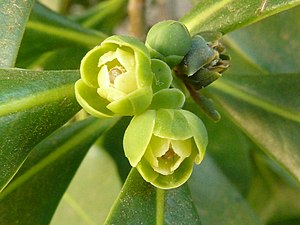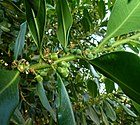Note: This is a project under development. The articles on this wiki are just being initiated and broadly incomplete. You can Help creating new pages.
Warburgia salutaris - Pepper-bark tree
Warburgia salutaris is a species of tree in the Canellaceae family. It is found in Botswana, Namibia, Tanzania, Zambia, Mozambique, South Africa, Swaziland, Malawi and Zimbabwe. It is threatened by habitat loss.
Contents
[hide]- 1 Uses
- 2 Parts Used
- 3 Chemical Composition
- 4 Common names
- 5 Properties
- 6 Habit
- 7 Identification
- 8 List of Ayurvedic medicine in which the herb is used
- 9 Where to get the saplings
- 10 Mode of Propagation
- 11 How to plant/cultivate
- 12 Commonly seen growing in areas
- 13 Photo Gallery
- 14 References
- 15 External Links
Uses
Malaria, Cold, Chest pain, Cough, Muscle pains, Stomach aches, General body pains, Diarrhea, Sore throats
Parts Used
Chemical Composition
The major oil constituents were myrcene (27.5 %), limonene (16.9 %), and (E)-β-ocimene (11.1 %) and (Z)-β-ocimene (9.5 %) among the monoterpenes, with α-humulene (5.6 %) and β-caryophyllene (4.7 %) among the sesquiterpenes.[1]
Common names
| Language | Common name |
|---|---|
| Kannada | |
| Hindi | |
| Malayalam | |
| Tamil | |
| Telugu | |
| Marathi | NA |
| Gujarathi | NA |
| Punjabi | NA |
| Kashmiri | NA |
| Sanskrit | |
| English | Pepper-bark tree |
Properties
Reference: Dravya - Substance, Rasa - Taste, Guna - Qualities, Veerya - Potency, Vipaka - Post-digesion effect, Karma - Pharmacological activity, Prabhava - Therepeutics.
Dravya
Rasa
Tikta (Bitter), Kashaya (Astringent)
Guna
Laghu (Light), Ruksha (Dry), Tikshna (Sharp)
Veerya
Ushna (Hot)
Vipaka
Katu (Pungent)
Karma
Kapha, Vata
Prabhava
Habit
Identification
Leaf
| Kind | Shape | Feature |
|---|---|---|
| Simple | Alternate | The leaves are simple, elliptic to lanceolate, 4.5-11 x 1-3 cm |
Flower
| Type | Size | Color and composition | Stamen | More information |
|---|---|---|---|---|
| Bisexual | 7–10 mm | Green | 5 | Flowers Season is June - August |
Fruit
| Type | Size | Mass | Appearance | Seeds | More information |
|---|---|---|---|---|---|
| 4 cm | Turning dark purple when ripe | Skin leathery, glandular, black when mature | 2 or more | {{{6}}} |
Other features
List of Ayurvedic medicine in which the herb is used
Where to get the saplings
Mode of Propagation
How to plant/cultivate
A plant of the tropics, where it is found at elevations from 1,000 - 2,200 metres. It grows best in areas where annual daytime temperatures are within the range 5 - 25°c, but can tolerate 10 - 35°[3]
Commonly seen growing in areas
Savannah woodland, Coastal forest, Afromontane forest.
Photo Gallery
References
External Links
- Ayurvedic Herbs known to be helpful to treat Malaria
- Ayurvedic Herbs known to be helpful to treat Cold
- Ayurvedic Herbs known to be helpful to treat Chest pain
- Ayurvedic Herbs known to be helpful to treat Cough
- Ayurvedic Herbs known to be helpful to treat Muscle pains
- Ayurvedic Herbs known to be helpful to treat Stomach aches
- Ayurvedic Herbs known to be helpful to treat General body pains
- Ayurvedic Herbs known to be helpful to treat Diarrhea
- Ayurvedic Herbs known to be helpful to treat Sore throats
- Herbs with Leaves used in medicine
- Herbs with Bark used in medicine
- Herbs with common name in English
- Habit - Evergreen tree
- Index of Plants which can be propagated by Seeds
- Index of Plants which can be propagated by Cuttings
- Herbs that are commonly seen in the region of Savannah woodland
- Herbs that are commonly seen in the region of Coastal forest
- Herbs that are commonly seen in the region of Afromontane forest
- Herbs
- Ayurvedic herbs that don't have flower, fruit and leaf photos
- Ayurvedic herbs that don't have seed photos
- Canellaceae




